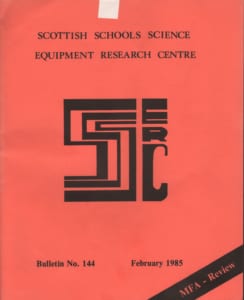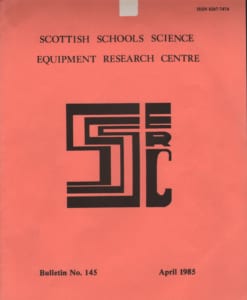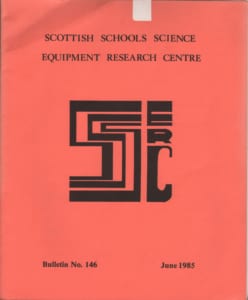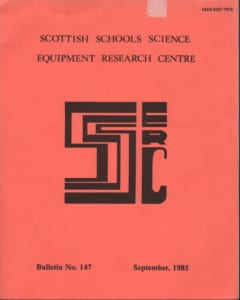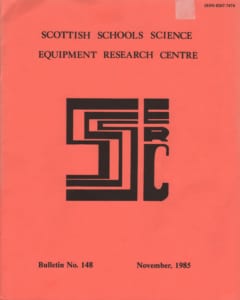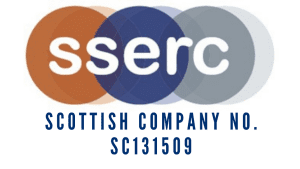The page numbers refer to the pages in the pdf. (The numbers in brackets are those given in the actual bulletin)
3(1) Introduction
Auf weidersehn tech.! Easter closure, Scottish Region ASE Annual Meeting, 1985, Cost Index, Biochemical Society: Schoolteacher Fellowships, Microelectronics monographs, The biter bit? No comment
5(3) Opinion —Kits in technology education
Problems with the usage of kits leading to a restriction of activities and hence a narrowing of curricular options.
7(5) CLEAPSE Guides
New and revised CLEAPSE guides available for borrowing.
7(5) Accident report – metal oxide reduction
A crucible filled with a mixture of zinc powder and copper(II)oxide was being heated when the crucible shattered violently, the detonation being heard by a colleague four floors down.
9(7) Stomatal counts
The traditional method for investigating stomata pattern and distribution is by a leaf peel technique, using, nail varnish. However this can be, in the wrong hands, very messy. We have recently been trialling an alternative technique based on the use of ‘cellulose acetate’ sheet and propanone (acetone).
10(8) Microscope spares
Spares availability for Carton Optical microscopes,
11(9) Microelectronics For All
We review the MFA programme. This is a short course on digital electronics produced by the Microelectronics Education Programme
19(17) Concrete beams
Methods for creating suitable sized concrete beams for testing as part of Standard Grade Science.
21(19) Threadstretcher
One of the problems common to all rigs for stretching threads or metal wires is the mode of anchorage. We offer a solution.
23(21) Stretching metal wires
An alternative to the device shown in the Standard Grade Science exemplar materials is described here.
25(23) ASE, Annual Meeting 1985
Some personal impressions from the meeting at Keele, Telecommunications in practice (Resources in the joint ASE and British Telecom project), Experimenting with industry (a project organised jointly by the ASE and the Standing Conference on School Science and Technology.
The page numbers refer to the pages in the pdf. (The numbers in brackets are those given in the actual bulletin)
3(1) Introduction
Surplus galore! Ecology courses
3(1) Methanal (formaldehyde)
Further guidance on the health effects of exposure.
5(3) Heart rate monitors
Three basic types of transducer together with broad categories of instrumentation for monitoring heart rate are described. Some other applications of certain items of equipment are mentioned. General questions of safety in electronic measurement in human physiology are discussed A summary table showing some selected features of equipment falling within the school price range is given.
12(10) Linearity of radiation detectors and the inverse square law
A comparative study of the linearity of several radiation detectors is given and the effects of this investigation on inverse square law experimental results are discussed.
15(13) Infra-red detector
A description is given of the design of a monitor of near infra-red based on the TIL 100 photodiode. This monitor proves, under the two—lamp test, to give a goodish linear response and is therefore suitable for quantitative work with infra-red radiation.
19(17) Surplus Equipment Offers
22(20) Electronics Notes
22(20) Trade News
Changes of address and name.
The page numbers refer to the pages in the pdf. (The numbers in brackets are those given in the actual bulletin)
3(1) Introduction
Susan Goodbye! Summer Saturdays, Royal Society of Chemistry Research Fund, Erratum Bulletin 145, Cost Index, Retiral Tribute (J.A.R. Hughes OBE BSc)
5(3) CLEAPSE Guides
CLEAPSE guides that may be borrowed.
6(4) Pollution – a practical pot-pourri
A number of mare recently developed Scottish curricular materials suggest some novel experimental and analytical techniques. This short note deals with two such activities, the effects of air pollution on plants and the detection or demonstration of lead pollution
8(6) Hydrogen cylinder incident
An experienced technician was filling balloons of hydrogen from a cylinder when the stream of gas ignited to produce a large flare. There had been no obvious sources of ignition in the room.
8(6) The burning of hydrogen
How to carry out this activity effectively and safely.
11(9) Interfacing Notes – Quiz game control
A construction project for a panel-game style, first-on-the-button controller, using a BBC micro.
13(11) The fine-beam cathode ray tube
An American journal, “The Physics Teacher”, has run a series of articles on investigations with a Teltron, fine-beam, cathode ray tube. We would like to draw your attention to this series.
13(11) Nuclear emulsions
The use of nuclear sensitive emulsions.
13(11) NiCad Cells – Help
Help required into a survey into the usage of rechangeable NiCad Batteries.
16(14) Shaft encoder circuits
A technical description of two shaft encoder systems is given. Whilst being useful in their own right as notes on instrumentation the main purpose is as applications of some common electronics principles.
26(24) Trade News
New oscilloscope, Oscilloscope repairs, polycarbonate sheet, uv lamps
The page numbers refer to the pages in the pdf. (The numbers in brackets are those given in the actual bulletin)
3(1) Introduction
Saturday opening, Arrangements for visitors, Surplus equipment offer.
4(2) Opinion
“Domesday’ physics?
6(4) Publications List
8(6) Light meter summary
The following table is a summary of data obtained from the evaluations of five light meters. This forms part of a wider examination into the theory and techniques of environmental Measurement.
9(7) Corrosion
Some background on the economic importance of corrosion prevention is outlined. Two further sources of educational ideas and information are given. Details are provided of procedures for examining two different aspects of corrosion and its prevention.
13(11) A.C. current measurement
Technical difficulties are presented by the accurate measurement of a.c. current in the milliamp range. In general this is due to signal degradation caused by the rectifier diodes within the a.c. milliammeter.
16(14) Surplus Equipment Offer
19(17) Power supplies Part 1
This is the first of an occasional series of articles on the design and construction of voltage regulated power supplies.
24(22) Trade News
Meters, Tools and materials, Thermometers, Catalogues.
The page numbers refer to the pages in the pdf. (The numbers in brackets are those given in the actual bulletin)
3(1) Introduction
Safety surfeit, Festive season closure, Erratum, No Comment, Comment
4(2) poisonous plant material
Accidental poisoning in children through the ingestion of toxic plant material has a long recorded history. Incidents have been sporadically reported in the educational literature for as long as most of us can remember. We give an update.
5(3) Petrol oxygen explosion
An incident and how to avoid further ones.
7(5) Bunsen valves
Dangers and how to minimise them
8(6) Gas tap fittings
We have received a report of a recent incident in England where a gas explosion resulted in injuries to five pupils and a teacher. The prime cause of the incident is believed to have been failure of anti-rotation devices on the gas tap fitting.
8(6) Picric acid
Earlier this year there was a considerable stooshie over the problems with the disposal of picric acid (2,4,6-trinitrophenol). We offer some advice.
9(7) ethyl benzoate hydrolysis
Despite the use of anti-bump granules, on a number of different occasions the flask contents had erupted violently through the top of the reflux condenser. We investigated and offer suggestions.
10(8) Safety signs
The period of grace given for older signs already in situ before 1st of January, 1981 and which did not comply with the new specifications comes to an end on 31st December, 1985.
11(9) “Microbiology” an HMI guide
A brief description of this useful publication.
11(9) Enzyme technology kits
A number of kits are analysed for relevance to current and possible new Scottish biology courses. Reference is made to earlier, more detailed reviews by another author as well as to a proposed SSSERC Guide.
19(17) Flux gate magnetometer
The flux gate magnetometer is a highly sensitive, vector reading, magnetic instrument. A description Is given of its operation and historical development, Its relevance and possible importance 1n physics education is discussed and some applications are described.
30(28) Ross & Lamont model house
A review of the various versions of this ‘house’.
33(31) SS5ERC “Microelectronics Monographs”

